#modular hull
Explore tagged Tumblr posts
Text
Clegg Holdfast and Mawhonic Start Their Engines
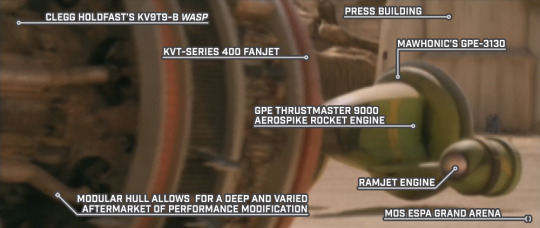
STAR WARS EPISODE I: The Phantom Menace - Deleted Scene: Complete Podrace Grid Sequence 05:42
#Star Wars#Episode I#The Phantom Menace#deleted scene#Complete Podrace Grid Sequence#Tatooine#Mos Espa#Mos Espa Grand Arena#Boonta Eve Classic#Clegg Holdfast's Podracer#KV9T9-B Wasp#KVT-series 400 fanjet#Press Building#Mawhonic's Podracer#GPE-3130#ThrustMaster 9000 aerospike rocket engine#ramjet engine#modular hull
0 notes
Text
Noble scion of a royal house, honored with a mech befitting her title and name. Bought by the population of three satellites, living, fighting and dying on her land. In her name.
Given the honor of being appointed squadron leader of her own platoon straight out of officer’s school, a trim and fit crew of 6 dolls. Outfitted in the same crisp uniform, with candy-colored hair and eyelashes, flawless skin.
Outfitted in plain-but sturdy lightweight frames. Equipped with rifles and high frequency blades. Modular, so if a part breaks it can quickly be replaced. The pilots, dolls, are modular too. Ready to be replaced.
As they glide over ice wastes and thermal vents, albedo burns and blisters her skin, leaving petty pock-mark scars and post-teenage acne in their wake. Her dolls are free of it. She hates them for it.
She’s sorely disappointed on her first sortie, launching into the battlefield from orbit, lance in hand, gallantly bearing her family’s crest and colors. Her dolls land shortly after, and set to work slaughtering Liberationists indiscriminately. By the time she can level her weapon at a combatant, something else swoops in to tear it to pieces. She should be happy. She’s not.
Denied even the pleasure of beating servants into submission, her crew already completely servile. Obsequient, really. Nothing like serfs or conscripts or convicts, who beg and plead and threaten under a polished bootheel. She beats them anyways. It doesn’t help her satisfaction. They thank her for the privilege. She should be happy.
She’s proud when they start calling her “the Witch”, takes it as a mark of pride that these useless automata are finally learning their place, until another officer tells her it’s a term of endearment for dolls. Then she hears it everytime, like nails on a chalkboard. “my witch”. “my witch”. “my witch”. mine.
She’s quickly promoted. She should be happy. She isn’t. They offer to appoint more soldiers to her squadron. She should take it. She doesn’t.
She orders her dolls to stand down, uses the officer’s passphrase to force them into immobility.
They watch as she rushes into her first proper sortie, still green-at-heart. She doesn’t bother dodging long-range fire. She doesn’t bother using her Lance’s reinforced point. She doesn’t bother skewering the cockpit, sinking herself into something warm and hot and squidgy to the hilt. She doesn’t bother ending it quickly. She batters and wallops and spits. Family colors scraped down to raw hull, family crest cratered by shells beyond all recognition. She should be happy.
When there’s one last survivor, and she’s finished prying off all its limbs, she opens the cockpit like an oyster, and extracts the wriggling rebel. She carries it back to her squadron like a prize. She gets to keep this one, another of her dolls.
83 notes
·
View notes
Text
Mandalorian Spacecraft Overview: Bes’uliik vs. Tra’kad


It was being escorted by a whole wing of dark, pretty wedges—Fett’s Bes’uliike—and a pair of flying boxes that could only be Mandalorian Tra’kads.
TRA'KAD - Mandalorian Warship
(Mando’a: “StarSaber”)
The Tra’kad is a compact war barge, optimized for troop insertion, boarding actions, and brute-force assault. It’s a flying tank built to deliver shock troops into the heart of battle.
The Tra’kad, translated as “StarSaber”, is a Mandalorian-designed multimission assault vessel, developed by MandalMotors as part of their modern fleet. Where the Bes’uliik is a precision strike fighter with symbolic elegance, the Tra’kad is a blunt-force, armored brute designed for transport, extraction, and direct ship-to-ship combat.
20 meters in length with a hull of beskar, it's armed with 6 cannon turrets and rotating modular weapon platforms. Requires one pilot and five additional crew members to fly, able to carry more than a dozen passangers.
One Roche negotiator described it as "primitive", but the Mandalorians see that as a compliment: simple, rugged, and reliable. Despite being smaller than capital ships, the Tra’kad fits into Mandalorian doctrine of mobility, aggression, and adaptability. The ship is more than hardware, it's a platform that allows for elite tactics: surgical strikes, boarding parties, and brute-force entries.
Compared to starfighters, it's more durable and transport-focused. Seen operating in tandem with Bes’uliike, using them as escort cover or bait while the Tra’kad carries commandos. Functions well in hit-and-fade tactics and urban conflict, especially when bringing Ori'ramikade (elite Mandalorian troops) into close combat.
“You can’t stop a Tra’kad.”
BES’ULIIK - Mandalorian Starfighter
(Mando'a: "Iron Beast”)
Leading the pack was the charcoal wedge of a Mandalorian Bes’uliik—large and somewhat ungainly, but still fast and powerful.
Named after the legendary Basilisk war droid, the Bes’uliik is a fast, durable strike fighter piloted only by Mandalore’s finest. Elegant in design, brutal in function. Described as ungainly but highly maneuverable, suggesting a starfighter that trades sleekness for brute force and armor. Like a flying tank that still moves like a knife.
15 meters in length with a hull of beskar, it's armed with 4 medium blaster cannons with 2 additional weapons mounts. Requires one pilot and up to two more crew to operate the additonal mounts.
Frequently serves as an escort ship, protecting blastboats and capital ships, and flying tight formations to block or draw fire. It can shrug off cannon bolts, and its nose armor is strong enough to absorb direct hits without sustaining serious damage. Flown primarily by Mandalorian veterans, and described as difficult for outsiders to pilot effectively, likely due to complex controls or tactical philosophy unique to Mandalorians. Equipped with cannon fire and missile systems, and used in direct attacks against heavy targets (e.g., bridges, emplacements, enemy corvettes).
The Bes’uliik isn’t just a fighter—it’s a modern war mount, armored in beskar, flown by warriors, and treated like a beast bred for glory.
Would you rather pilot a pretty but ungainly wedge or an indomitable box? Tell us in the comments below!
#star wars#mandalorians#mandalorian culture#boba fett#bes'uliik#tra'kad#the mandalorian#mandalorian#mavla originals collection
22 notes
·
View notes
Text
i remade and modernized the Leman Russ tank for my custom Guard army, bringing in elements of the T-55 as well as the Rogal Dorn to make a vehicle that is sleeker and much more sensible
its also both fully modular and fully posable; the turret spins (and can be taken off), the sponsons and hull gun both rotate, and i can remove their housings to replace them with other weapons, so i can always have a full loadout for whatever my list needs
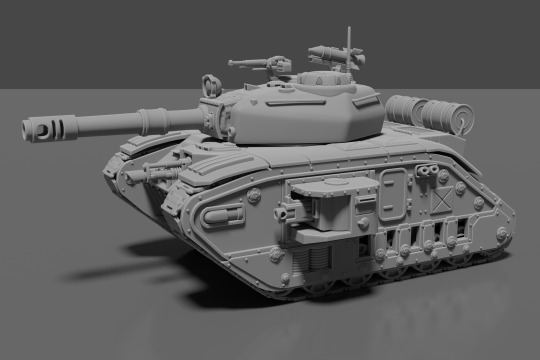
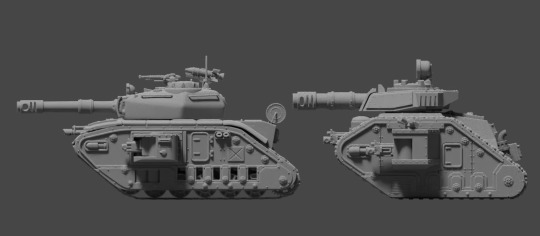
here's a scale comparison to the regular Leman Russ; I don't think anyone can accuse me of modelling for advantage
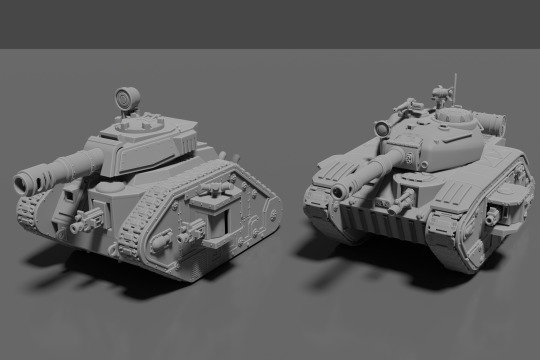
200 notes
·
View notes
Text
“The differences to explore were really fun. A lot of the Coruscant sets are domestic interiors. There is not much available off the shelf, so Rebecca had to design every piece of furniture. Syril’s (Kyle Soller) mother, Eedy’s apartment, is a good example, which in my mind was once a sought-after modern apartment in a newly built part of town, a high-rise with a modular interior with elements one could plug and play into the walls and upgrade. Syril, one of the most interesting characters in the show, grew up here under the thumb of Eedy his mother, but now the apartment is dated. It’s gone from crisp cream to Bakelite beige and has since been surpassed by other surrounding tower flats that have occluded the view to the sky. A view in my mind would definitely be a class issue in Coruscant.”
- Luke Hull on Eedy Karn’s apartment
#star wars#Andor#Eedy Karn#Syril Karn#Luke Hull#Coruscant#‘a view would definitely be a class issue on coruscant’ so true
110 notes
·
View notes
Text
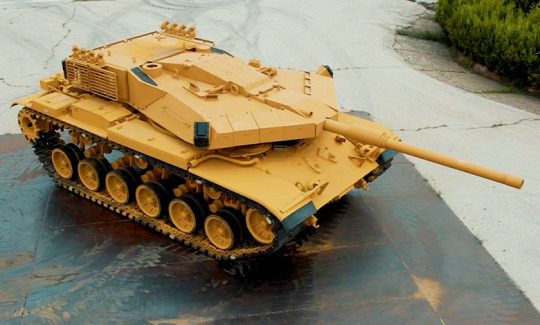
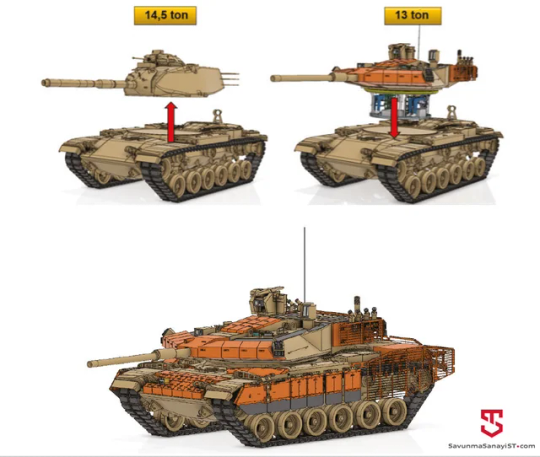
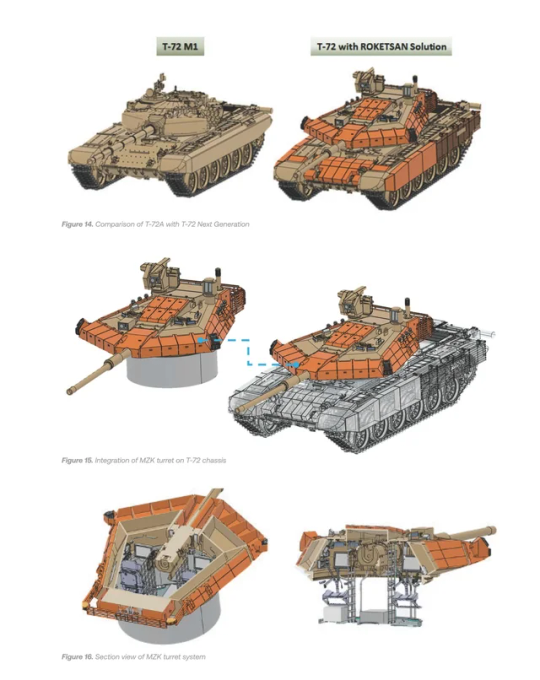
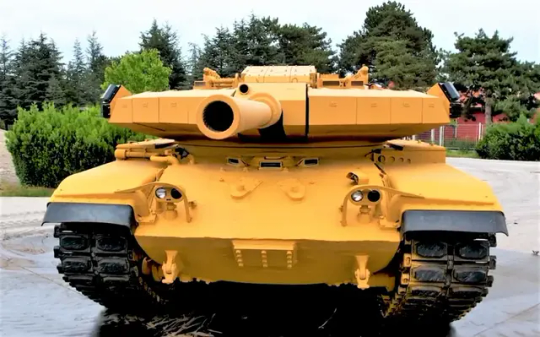
MZK turret, a Turkish modern modular turret capable of being retrofitted into older MBT hulls for an inexpensive upgrade, seen here on a M60 hull.
43 notes
·
View notes
Text
Of Gods and Men
Targaryen Harvesters
main list (where the story is)

This is Dune/GOT/HOTD/FAB/ASOIAF crossover AU that you've voted for. If you always wanted to see House Targaryen in space, I got you. Please note how some of the lore of both universes is bent to blend in both worlds. This is my original idea that I've been cooking for at least two years. Be gentle with my work, and enjoy the ride.

The Targaryen Harvester, a marvel of advanced engineering and ancient design, stands as a testament to the ingenuity and technological prowess of House Targaryen. Built to operate in the most inhospitable environments, it is a perfect fusion of cutting-edge technology and the almost mystical properties of drakaon crystals, which form the core of all Targaryen machinery. This harvester is unlike any spice-collecting machine in the known Imperium, combining both efficiency and subtlety in ways that make it a formidable tool on Arrakis.
Exterior Design & Structure
Chassis and Hull: The harvester’s body is sleek and aerodynamic, crafted from composite alloys that blend carbon-based materials with a mysterious Valyrian steel derivative. This combination makes the harvester both lightweight and incredibly durable, capable of withstanding the harsh, abrasive sands and the extreme temperatures of desert worlds like Arrakis.
Stealth Coating: The exterior is coated with a black, matte material that absorbs and disperses radar and infrared signals, giving it a degree of stealth that makes it nearly invisible to most scanning technologies. This also helps the harvester blend seamlessly into the shadowed dunes during night operations.
Compact Size & Modular Design: Unlike the large and cumbersome spice harvesters of the Harkonnens, the Targaryen Harvester is compact, designed for mobility and ease of deployment. Its modular nature allows it to be quickly assembled or disassembled, enabling rapid deployment or withdrawal from the field when needed.
Propulsion & Movement
Hover Technology: The Targaryen Harvester employs an advanced hover propulsion system, powered by drakaon crystals. This system allows it to float just above the surface of the sands, minimizing disturbances and vibrations that might otherwise attract the attention of the sandworms. The hover technology is fine-tuned to maintain stability even in rough terrain, allowing the harvester to glide effortlessly over the undulating dunes.
Adaptive Wings: As part of its hover mechanism, the harvester has retractable wing-like structures that extend from its sides during operation. These wings are not for flight but rather serve as stabilizers that adjust to wind currents and shifting sands, ensuring smooth movement over the desert landscape. When not in use, the wings fold seamlessly into the body of the harvester, maintaining its streamlined shape.
Harvesting Mechanism
Siphoning Arrays: The core feature of the Targaryen Harvester is its siphoning arrays, located within the wing-like extensions. These arrays create a controlled vortex of air that draws in sand and spice, separating the two with a precision unmatched by traditional harvesters. The vortex is generated using ionized air currents created by the drakaon crystal cores, which create a powerful yet gentle pull that sifts through the sands.
Crystal-Based Filtration System: Once the sand and spice are drawn in, the harvester uses a series of crystal-based filters to isolate the precious melange from the surrounding sands. These crystals, sourced from Albiron, possess unique electrostatic properties that attract and bind to the spice particles, allowing the purified spice to be collected while the sand is expelled back onto the ground.
Non-Disruptive Extraction: The process of harvesting is incredibly silent compared to the rumbling, clunky harvesters of the Harkonnens. The low hum emitted by the crystal-powered engines is barely audible even in the stillness of the desert night. This low impact is essential in minimizing vibrations, reducing the risk of attracting shai-hulud, the great sandworms of Arrakis.
Energy Core & Power Source
Drakaon Crystal Core: The heart of the harvester’s power is the drakaon crystal core, a dense, multi-faceted crystal that draws energy from ambient solar radiation and stores it for continuous operation. This core allows the harvester to run for extended periods without needing external fuel sources, making it self-sufficient and capable of long-range operations in remote areas of the desert.
Solar Collectors: In addition to the crystal core, the harvester is equipped with solar collectors that deploy during the day. These collectors absorb solar energy, supplementing the crystal’s power reserve and ensuring that the harvester can operate continuously, even under the harsh sun of Arrakis.
Control Systems & Interfaces
Holographic Interface: The harvester features a holographic interface for its operators, projected from a crystal-based control console within the cockpit. This interface displays real-time data on the harvester’s status, spice yield, and environmental conditions, allowing for precise control of the siphoning process.
Neural Feedback System: Advanced Targaryen technology allows for a neural feedback system that connects the operator’s movements with the harvester’s controls. This creates a near-instantaneous response between the operator’s commands and the vehicle’s actions, enabling delicate maneuvers even in unstable terrain.
Remote Control Capabilities: The harvester can be operated remotely from a command ship or a Targaryen control station, making it possible to manage multiple harvesters simultaneously over a wide area. This remote control system is encrypted and designed to be impervious to conventional Imperial hacking methods.
Defensive Features
Energy Shields: Although primarily a civilian machine, the Targaryen Harvester is equipped with low-level energy shields derived from ancient Valyrian technology. These shields are designed to deflect micrometeor impacts and protect the harvester from smaller projectiles or environmental hazards. While not suitable for full combat, the shields provide an added layer of protection against sabotage.
Electrostatic Discharge Mechanism: To deter potential attacks or interference, the harvester can release a controlled electrostatic discharge through its siphoning arrays, disrupting nearby electronics and creating a localized EMP burst. This can disable smaller drones or tracking devices, allowing the harvester to slip away undetected.
Environmental Adaptability
Climate Adaptation Systems: Designed to function in the extreme climates of desert worlds like Arrakis, the harvester is equipped with systems that regulate internal temperatures and prevent overheating. The materials used in its construction have been treated to withstand corrosive sands and thermal expansion, ensuring long-term durability in harsh conditions.
Low-Friction Hull Design: The harvester’s hull is coated with a low-friction material that prevents sand from accumulating on its surfaces, reducing wear and ensuring that the machine can maintain its optimal performance even during extended operations in sandstorms.
Unique Features
Spice Purification Module: A specialized chamber within the harvester is dedicated to refining the spice it collects. This module uses a process that enhances the purity of the melange, making it more potent and valuable. This capability is part of what makes Targaryen spice so desirable—and so mysterious.
Integrated Holographic Cloaking: For operations that require stealth, the harvester can activate a holographic cloaking field, bending light around it to become nearly invisible against the shifting sands. This feature is rarely used, as it drains the crystal core’s reserves significantly, but it can be invaluable for avoiding detection during sensitive missions.
#hotd x dune crossover#got x dune crossover#asoiaf x dune crossover#dune#crossover#fire and blood#harvester#house targaryen#house of the dragon#asoif/got#a song of ice and fire#game of thrones#dune x reader
12 notes
·
View notes
Text
What ships and stations look like in my SiFi Setting.
Cosmic Federation: Federation space-faring technology is often based around manufacturing base sections of facilities first, and assembling them around the engine, attaching them like lego. This leads to a very blocky look to some ships, but easy modularity and cross-compatibility. Newer stations, especially planet-bound ones, have a very Brutalist look, though as things develop more some more variety is added. Humanity brings their culture with them for the interiors.
..
The Commonwealth: Civilian ships have a very “nautical” feel to them, often looking like historical sailboats, a deliberate practice to maintain the Nyat connection to their history. The warships are sleek and maneuverable, even the larger ones. Stations for the Commonwealth are full of nature and art. Given the loss of the Nyat homeworld because of the civil war, the determination to maintain their culture in space makes sense.
The member cultures of the Commonwealth, such as the Rex’can and Man’tai, take notes from the Commonwealth but have their own spins on things.
Rex’can do not make distinction between warship and civilian vessel for their own fleets, thus every ship made has combat potential (even if it lacks visible armament).
The Man’tai design their ships after the animals of their homeworld, predatory lizard-beasts for the warships particularly.
..
The Sanctuary Republics: FLYING FUCKING CASTLES! The ability to create is the gift of the divine in the Fal’kor society, thus Republic ships are masterworks of art and science. Civilian ships have grand artworks painted on the hulls, their stations adorned in many murals, awe inspiring displays of faith, history, and industry.
Their warships bring a greater “Cathedral” look, though the number of warships the Republic has in its possession is limited, because they get very resource intensive quickly.
..
The Grand Unity: Because of the diverse number of species the Unity, their ships often resemble trains, different cars accommodating the needs of individual species with several “cars” serving as places of meeting between cultures. Stations emulate this idea, several sections divided up but built around a central facility.
The warships maintain the “train” idea, and a fleet of the Unity’s ships is often compared to a dance of dragons in how they maneuver around each other
6 notes
·
View notes
Text
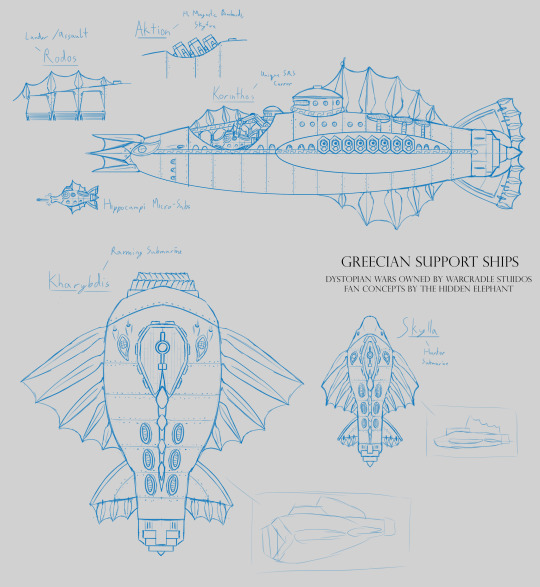

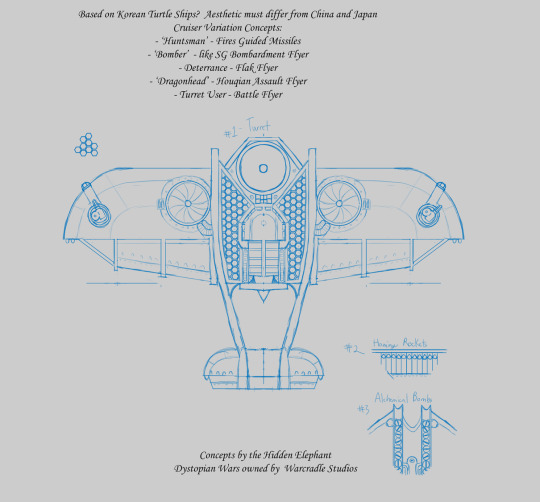

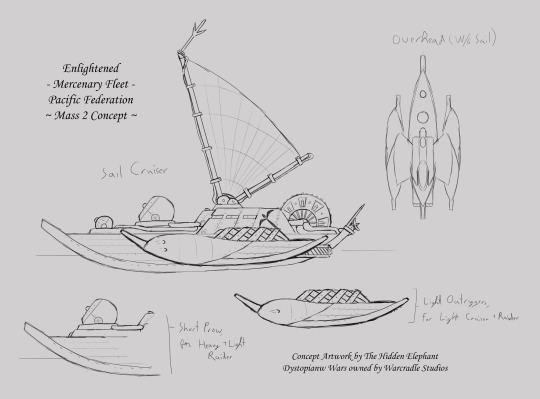
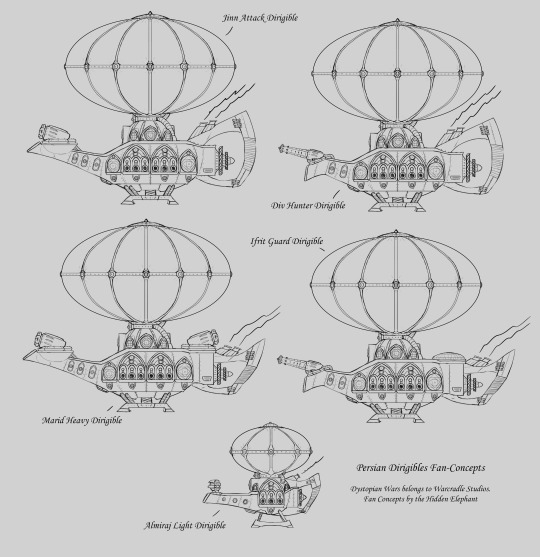
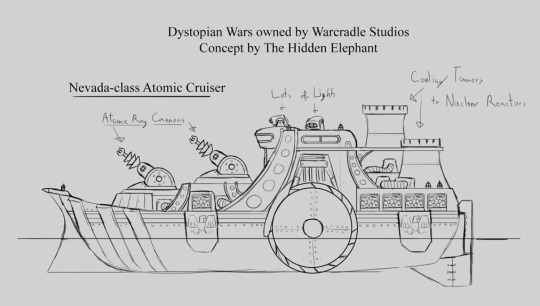
Picture dump time! These are fan-sketches I made of Dystopian Wars, my latest miniatures wargaming obsession. Turns out, I like boats and I cannot lie. Dystopian Wars (DW) is a steampunk/dieselpunk/atompunk alternate history wargame taking place in the year 187X, where great powers have great technology and lack great responsibility. The pictures are not in chronological order; I started with the Korean crafts, did the Polynesian ships and then the Union Atomic ship, then the Greek page, then the Persian Airships. Koreans and Greeks are going to be in the game, so they're baseless speculation on my part. Polynesians were a fan-thing for the Enlightened faction, and I wanted to include a bit of Solarpunk in the designs. Verdict is still out on that. Persian Airships are ludicrous fantasy on my part, based out of the idea of using an archetypical oil lamp as the hull for an airship. In addition, DW has a strong modularity component to it. Each plastic kit can build one thing out of several options, leading to great flexibility in the kits. The Prussians are the best example; if you don't glue down the bridge and primary weapons, you can just have any ship you could build with that kit. I tried duplicating that effect in sketch form, but with the Persians I got fed up and assembled full images of each variation.
#Dystopian Wars#dystopian#science fiction#steampunk#dieselpunk#atompunk#solarpunk#alternate history#miniatures wargaming#wargames#wargaming#Warcradle Studios#Fanwork#airship#dirigible#balloon#catamaran#Sketch#aircraft#turtle ship#aircraft carrier#submarine#submersible#the wide ocean#mechanical fish#atlantis#Sultanate#Empire#Enlightened#Union
28 notes
·
View notes
Photo

PG-192 Self Propelled Artillery Vehicle
Commission work Following the wake of the first Echerion-Starsect war, the Starsect Republic recognized a dire need in a commonpool armored combat vehicle, as both the strain to logistics of having to supply hundreds of different models of tanks, as well has having to train their crews should one of them fall, was enough to give pause to any military force. The plan was for a single family of vehicles that could be adapted to any changing combat situation and need, from the ubiquitous main battle tank, to armor recovery vehicles, that placed a very strong emphasis on crew protection at all costs. The tank that would lay claim to its fame had its predecessor on Riria tested brutally during the Echerion Syndicates twelve year long siege of the planet. Taking lessons learned during the siege and the various battles that other comparable AFVs were involved with, the company that would ultimately win the contract for the Advanced Armored Combat System program, presented what would later be dubbed the T-190 Therus, a vehicle that showed astonishing promise, with extreme ease of modularization, modification, and strong emphasis on ease of manufacture and maintenance, without compromising the republic's crew survivability requirement, the proto-Therus won in every category with flying colors. While expensive initially, and in spite of many naysayers within the complicated web of the republic's bureaucracy, the new Therus proved to be well worth the investment on a multitude of worlds, especially ones that nearly had their armor cores wiped out by the fanatical forces of the syndicate and were in dire need of an upgrade. It however would not be until the second Echerion-Starsect war where the tank was able to truly test its metal against the syndicate armor and infantry forces. While not uncommon for various Therus tanks to be taken out of action by other tanks or mainly infantry forces with ATGMs, it served its main purpose well in keeping its crew safe, and of course proving its extreme reliability in tandem with its adaptability, the tank served its crews well, and earned its respect in the eyes of many within the Ranger Corps and newly forged Predator Legions, and earning itself an equally fearsome reputation with the forces of the syndicate. The Therus since has served the republic well for the better part of nearly 20 thousand standard years, and the design has seen very little in terms of any major changes, apart from hull armor material composites, electronic equipment upgrades, redundancy backups, and even engines, it still holds itself to the original operational promise of crew survivability and protection, as well as extreme mission flexibility, a reputation that is unrivaled by any comparable military hardware, even in the present day. While a jack of all trades is a master of none, the Therus proved that it's far better than a master of one. Do not use this design without permission.
4 notes
·
View notes
Text
I finally had time to devote to Steampunk Strangetown, and got the Grunt family set up and completed my remodel of... that one community lot whose name I cannot recall. I may rename it something like Specter's Landing, as it is the initial landing pad for the colonists which has become a docking station and a small cluster of shops and trading posts.
















The clothing store now has some empty shelves for selling sim-produced goods, and a second floor of more shelves, up a space-saving wrought iron spiral staircase.
The game store is now a chapel again, a simple setup for sims to wed.
The grocery store lost its dining tables in favor of a variety of produce displays and, like the clothing store, a few empty shelves for selling food harvested at the colony itself.
The pool house has been transformed into an impressive edifice of a docking station, winding its way up around some machinery. I may yet add more decoration, but for now it's mainly just a big fancy staircase going up to the roof for airship access.
The airship uses a 3t2 houseboat hull, Sphere 360 pieces, and modular greenhouse roof pieces, as well as whatever industrial and steampunk decor I could scrounge up. I'm very pleased with the results, although I would like to figure out whether these CC pieces can be used to construct a reasonable-looking but much bigger airship, something sims would use for an extended journey.
I may take another pass at this lot eventually--it's less dirty but still pretty quick. I may want to change the shape of the grocery store, edit the roads to match a default replacement, and put in all the ceilings I always forget to add--but it's completed to my satisfaction, and I will be happy to have my sims shop here.
It's probably going to be owned by Olive Specter, as she's the aristocrat in charge of the colony. I haven't totally decided what to do with the pool lot, but I am probably going to convert it into a mine.
...I finished the Grunts but forgot to take photos. Next time!
3 notes
·
View notes
Text
Building a cargo spaceship capable of exploring our solar system based on current technology and the knowledge gleaned from our understanding of engineering, science, and chemistry requires us to work within practical and realistic constraints, given that we're not yet in an era of faster-than-light travel. This project would involve a modular design, reliable propulsion systems, life support, cargo handling, and advanced automation or AI. Here’s a conceptual breakdown:
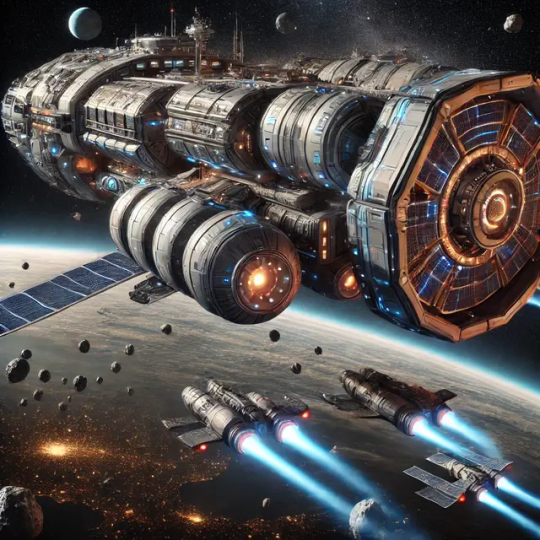
1. Ship Structure
Hull and Frame: A spaceship designed for deep space exploration needs a durable, lightweight frame. Advanced materials like titanium alloys and carbon-fiber composites would be used to ensure structural integrity under the stress of space travel while keeping the mass low. The outer hull would be made with multi-layered insulation to protect against micrometeorites and space radiation.
Dimensions: A cargo space vessel could be roughly 80-100 meters long and 30 meters wide, giving it sufficient space for cargo holds, living quarters, and propulsion systems.
Cost: $500 million (materials, assembly, and insulation).
2. Propulsion Systems
Primary Propulsion: Nuclear Thermal Propulsion (NTP) or Nuclear Electric Propulsion (NEP):
NTP would involve heating hydrogen with a nuclear reactor to achieve high exhaust velocities, providing faster travel times across the solar system. NEP converts nuclear energy into electricity, driving highly efficient ion thrusters. Both systems offer relatively efficient interplanetary travel.
A hybrid solution between NTP and NEP could optimize fuel efficiency for longer trips and maneuverability near celestial bodies.
Cost: $1 billion (development of nuclear propulsion, reactors, and installation).
Fuel: For NTP, hydrogen would be used as a propellant; for NEP, xenon or argon would be the ionized fuel. It would be replenished through in-space refueling depots or by mining water on asteroids and moons (future prospect).
Cost (fuel): $50 million.
3. Power Systems
Nuclear Fission Reactor: A compact fission reactor would power the ship’s life support, propulsion, and onboard systems. Reactors designed by NASA’s Kilopower project would provide consistent energy for long missions.
Backup Solar Arrays: Solar panels, optimized for efficiency beyond Mars’ orbit, would serve as secondary power sources in case of reactor failure.
Cost: $300 million (including reactors, solar panels, and energy storage systems).
4. Cargo Modules
The cargo holds need to be pressurized and temperature-controlled for sensitive materials or scientific samples, while some holds could be left unpressurized for bulk materials like metals, water, or fuel.
Modular Design: The ship should have detachable cargo pods for easy unloading and resupply at different planetary bodies or space stations.
Cost: $200 million (modular design, pressurization systems, automation).
5. Life Support Systems
Water and Oxygen Recycling: Systems like NASA’s Environmental Control and Life Support System (ECLSS) would recycle water, oxygen, and even waste. These systems are key for long-duration missions where resupply may be limited.
CO2 Scrubbers: To remove carbon dioxide from the air, maintaining breathable conditions for the crew.
Artificial Gravity (optional): A rotating section of the ship could generate artificial gravity through centripetal force, improving the crew’s health on longer missions. However, this would increase complexity and cost.
Cost: $200 million (life support systems, with optional artificial gravity setup).
6. AI and Automation
AI-Controlled Systems: AI would manage navigation, propulsion optimization, cargo handling, and even medical diagnostics. Automated drones could be used for ship maintenance and repairs in space.
Navigation: Advanced AI would assist in calculating complex orbital maneuvers, interplanetary transfers, and landings.
Autonomous Cargo Handling: Robotics and AI would ensure that cargo can be efficiently moved between space stations, planets, and the ship.
Cost: $150 million (AI development, robotics, automation).
7. Communication and Sensors
Communication Arrays: High-gain antennas would allow for deep-space communication back to Earth, supplemented by laser communication systems for high-speed data transfers.
Radars and Sensors: For mapping asteroid belts, detecting anomalies, and navigating planets, advanced LIDAR, radar, and spectrometers would be necessary. These sensors would aid in planetary exploration and mining operations.
Cost: $100 million (communication systems, sensors, and diagnostics).
8. Radiation Protection
Water Shielding: Water, which is also used in life support, would double as a radiation shield around the living quarters.
Electromagnetic Shields: Experimental concepts involve creating a small electromagnetic field around the ship to deflect solar and cosmic radiation (early TRL, requires more development).
Cost: $50 million (radiation shielding).
9. Crew Quarters
Living Quarters: Designed for long-duration missions with the capability to house 4-6 crew members comfortably. The quarters would feature radiation protection, artificial lighting cycles to simulate day and night, and recreational facilities to maintain crew morale on multi-year missions.
Medical Bay: An AI-assisted medical bay equipped with robotic surgery and telemedicine would ensure the crew remains healthy.
Cost: $100 million (crew quarters, recreational facilities, medical systems).
10. Landing and Exploration Modules
Surface Exploration Vehicles: For landing on moons or planets like Mars or Europa, a modular lander or rover system would be required. These vehicles would use methane/oxygen engines or electric propulsion to take off and land on various celestial bodies.
Cost: $300 million (lander, rovers, exploration modules).
---
Total Estimated Cost: $2.95 Billion
Additional Considerations:
1. Launch Vehicles: To get the spacecraft into orbit, you would need a heavy-lift rocket like SpaceX’s Starship or NASA’s Space Launch System (SLS). Multiple launches may be required to assemble the ship in orbit.
Cost (launch): $500 million (several launches).
2. In-Space Assembly: The ship would likely be built and assembled in low-Earth orbit (LEO), with components brought up in stages by heavy-lift rockets.
Cost: $200 million (orbital assembly infrastructure and operations).
---
Grand Total: $3.65 Billion
This estimate provides a general cost breakdown for building a cargo spaceship that could explore and transport materials across the solar system. This concept ship is realistic based on near-future technologies, leveraging both nuclear propulsion and automation to ensure efficient exploration and cargo transportation across the solar system.
#canada#canadian politics#space#science#scifi#scifiart#sci fi and fantasy#nasa#nasa photos#elon musk#share#engineering#ideas#ai#scientificresearch#billionaire
6 notes
·
View notes
Text
GT July 2024 - 22 Lost
“Robert Falcon!” A light mechanical voice pierced Rob’s ear. “I swear to the Astral Winds that if you don’t get that lifeboat functional again, I’m going to make you sleep in it!”
Rob rolled his eyes, but replied, “I’m already working on it, ma’am.” He was harnessed to the malfunctioning lifeboat, hanging upside down off its stern, using his AR Link to scan its hull. The ship’s core had flagged this boat with an error but hadn’t specified what the problem was. So far, his diagnostic disagreed. There were a few more things to check, but he grinned, “As far as I can tell, it’s in ship shape.”
The chief’s groan was music to his ears.
“Plus, I wouldn’t mind sleeping in the lifeboat. It’s a much better view, and significantly less smelly.” Rob pointed out.
As the only engineer’s assistant on board, he had the dubious honor of sharing a room with the Chief Engineer. On the bright side, the chief engineer was an ornery crestframe who didn’t need a real bunk to rest, while Rob was a plucky teenage human who very much enjoyed sleeping in a bed instead of a hammock. Since the chief didn’t use it, she let him sleep there despite his very junior rank. The smell was mostly from the various fluids the ship needed to keep running smoothly. All of which ran through its core room, which was naturally where the chief and Rob slept.
If he slept in the lifeboat though, he’d be outside, sleeping among the lights of the Astral Canopy. The Astral Winds, solar currents flowing with the energy that powered their ship would lull him to sleep every night. He wouldn’t have to listen to the sounds of machinery keeping them all alive and moving. Or at least it would be quieter anyway. He’d been joking with the chief, but maybe he should delay a bit. It might be better to sleep out here.
“That can be arranged,” the chief informed him. “I’d sure love to see what happened to you the first time we get a bit too close to one of the solar currents.”
Well, the Chief had a point there. The lifeboats were tied up outside the hull of the ship, and therefore, outside that hull’s protection. The hull of their ship, and her lifeboats, were made of solar wood. Wood that had been infused with the elemental energies of fire and light. They’d be fine if they got closer than ideal to a solar current. But a lifeboat wouldn’t protect Rob from the streams of energy that came from the sun. He’d disintegrate. Which would put a downer on his day.
“All right, all right,” Rob grumbled. “But I don’t see any problems here. Everything’s checked out so far. Maybe there’s something wrong with the connection between the cores?”
The chief grunted, and Rob could almost hear her mechanical brain’s cogs turning. “Could be. Check it out.”
Rob pulled himself into the lifeboat proper. The lifeboat was more of a dinghy than anything else. It was ten feet long, with a single solar sail, a very small core to transform the energy gathered from the sail into thrust, and a tiller to guide where that thrust was directed. The core was also what would communicate with any other ship’s cores in the area.
Rob pulled the core out of its setting. It was a clump of crystal orbs attached to a central power core about the size of his fist. A vessel the size of a lifeboat only needed a single cutter-grade power core. It also had modular crystals for communication, signal amplification, life support, and shields. He scrutinized the crystals, his AR goggles displaying diagnostic information in the corner of his vision.
“Ah!” He grinned. “Got it. The signal amplifier’s backup power core isn’t drawing power from the main core. I just need to replace it.”
There was a moment of silence over the com as Rob dug in his pack for a spare micro power core. He was pretty sure he’d thrown one in here before he’d come out. Or maybe that had been a cutter core? Great. Now he wasn’t sure.
“Are you sure that’s it?” The chief asked. “The ship’s core seemed mighty concerned if it was only a backup power core replacement.”
Rob frowned. That was another good point. The ship would have marked that as a medium-priority malfunction. This was a high-priority error.
The lifeboat shifted under Rob. He lurched and grabbed the side of the boat, looking around with wide eyes. The core fell from his hand, and gently floated back to its setting.
“What was that?” Rob called.
“What was what?” The Chief asked.
“The lifeboat moved.”
“How’d it do that? It’s tied up.”
“I don’t know, but it did.”
“It is tied up right?” The chief asked.
Rob looked up at where the boat was tied to the hull of the ship. The backup lines were good and tight, but the main latches were slowly opening. The latches were mechanical. The lines were just ropes. Theoretically, the lines would keep the lifeboat attached, but not if the ship made any sort of fast maneuvers.
“That’s not good,” Rob announced.
“Robert Falcon, get off that lifeboat this instant!” The chief shouted.
Rob glanced back at the boat’s core and saw the actual problem now. It was hard to see, even with his goggles, but deep in the main power core of the lifeboat was a spot of darkness.
“Chief! It’s been corrupted!” Rob shouted. He jumped for the core and ripped it out of its setting. If that corruption spread to the ship’s core through its com mod, they’d all be worse than dead. The corruption would infect the ship’s core, turning her against her sailors.
They’d never survive. Neither would the ship.
Rob looked at the core in his hands, unsure what to do with it.
“Don’t just hold it you damn fool, throw it overboard!” The chief shouted. Rob looked up. The chief was now at the ship’s railing looking down at him. The crestframe’s body was a hodgepodge and jury-rigged affair. Most captains would have thrown her out at first glance. But not Rob’s captain. She’d recognized something in the old crestframe, and it turned out, the chief was the best solar engineer in the seven astral seas.
Rob did as he was told. He moved to the far side of the lifeboat and threw the core overboard as hard as he could. He needed to throw it with enough force to get it out of the ship’s artificial gravity. He chucked it as hard as he could. For a moment, the core slowed in the air as the ship’s life support mod tried to pull it back. But then it hit the edge of the gravity well and started floating away into the distance of the Astral Canopy.
The knot in Rob’s chest loosened, and his heart rate started to settle. Then his stomach jumped into his throat as the lifeboat fell from the ship.
“No, no, no, you blasted barge!” The chief’s voice cracked. How did a mechanical lifeform’s voice crack? “We took care of it! You don’t have to eject!”
Rob’s entire body went cold. The ship had sensed the corruption. She was trying to save herself and her crew by severing the connection to the infected core. The only way she could do that without prior authorization was to get rid of the entire lifeboat. She had reversed her local gravity for the lifeboat, shooting it off into the heights of the Astral Canopy, along with Rob.
It was too late for anyone to stop it. The lifeboat was already past the edge of the ship’s gravity well and was going on the opposite vector of the ship. It gave Rob an excellent view of the solar sailor that had been his home over the last few years. The solar wood of the ship was a dark reddish-orange color. Unlike a seafaring vessel, which had masts going straight up, a solar sailor had masts shooting out in three directions. One straight up, and two out of the hull, angled downward so that its sails looked like a triangle around the ship. The solar sails were shimmering gold with the captured energy of the solar currents.
The ship skewed into a hairpin turn. The chief was working fast. The ship was already coming about after him, but it wasn’t going to be fast enough. They’d been going at nearly maximum speed. Already, the ship was vanishing into the darkness, no longer visible to the naked eye. The depowered lifeboat would get lost against the ambient echoes and solar energy of the Astral Canopy. The ship’s sensors wouldn’t be able to find him alone.
Normally, that wouldn’t be a huge deal. These lifeboats were designed to be found. But it was the boat’s com mod that sent out that signal. The very com mod that had been attached to the core Rob had thrown overboard. His AR link could be tracked a short distance. But the lifeboat was moving fast, and he was already past that. The chief and the Captain would be able to make a good guess about his trajectory, but it would still be like finding a needle in a haystack. They’d be relying on luck as much as anything else.
Unless Rob could find a way to amplify the signal of his AR link.
Rob let out another breath and relaxed again. He could do that. He just needed to give his AR link some more power. He grabbed his pack and found the backup power core he’d been looking for at the very bottom. He just needed to connect his AR link to it, and that should get the job done. No big deal.
The lifeboat jerked to a halt, throwing Rob into its mast hard enough for him to see stars for a second, and giving him an instant headache. The hairs on the back of his neck stood up. The lifeboat shuddered.
Something had caught the lifeboat, and it hadn’t been a ship’s tractor line. There were any number of creatures in the Astral Canopy that might be interested in a free-flying lifeboat. Most of them would be quite pleased to find a nice, tasty human inside.
Rob looked around with only his eyes for options. There was a pistol in the storage compartment. But that was all the way over on the other side of the boat. Rob’s crest wasn’t fully awakened yet. It was connected to the ship, and if he’d been there, his crest might have helped him. But he wasn’t. He was defenseless.
His eyes landed on the micro power core in his hands. It was the only realistic chance he had of the ship finding him. But it was also the only possible weapon he had against whatever was about to try and eat him.
The boat lurched harder, and Rob jumped into action. He didn’t make a conscious decision. It just happened. He spun as he connected his AR link to the power core. Instead of using the core to overpower his AR Link, he used all the remaining power in his AR Link to overcharge the micro power core. So overcharged, it would explode if someone blew on it too hard. Rob only had to give the command. Rob turned to see what creature was trying to make a snack of him, and his heart tried to jump out of his chest at the same as his stomach tried to escape through his backside.
It was a jelly slime.
Jelly slimes were only barely alive. They were a type of ooze that had adapted for the Astral Canopy. They consisted of a ship-sized blob of acidic ooze that served as their bodies, and tentacles of paralyzing ooze that reached out from that body in all directions. As it floated along through the canopy, anytime those tentacles brushed up against something, they immediately stuck to it pulling close to the main body. When its prey touched the main body, the slime would engulf it, and begin breaking it down to add more mass to itself. It wasn’t a quick process either. The slime’s body would paralyze anything alive inside of it while simultaneously keeping it alive. The victim would be slowly digested alive, which could take days.
On average, they were the size of a large astral barge. This one was small. It was only the size of a solar sailor. Which was still plenty large enough to completely swallow Rob and his lifeboat.
But Rob and the boat were still on the fringes of the jelly slime’s reach. Only one tentacle had latched on. If Rob could get that off his boat, he might be able to get away before the other tentacles snagged him.
Rob threw the power crystal at the tentacle. It hit with a plop, but Rob hadn’t thrown hard enough. The core was only a few feet from the edge of the lifeboat. That was too close. If Rob blew it up that close, it might destroy the ship as well.
More tentacles were heading his way. The tentacle that had grabbed the boat was starting to pull. He didn’t have time. It’d be better to die quickly in an explosion than slowly in the belly of a jelly slime.
Rob triggered the power crystal, and everything went white.
---
This is actually the first chapter of Rob and Wyll's story. But it fit so well with the prompt that I just had to do it. Not a lot of GT for GT July I guess though. Oh well. It gives a bit of context for all of the other prompts you've seen them in.
Check out the prompt list here: https://www.tumblr.com/gianttol/751027101880270848/gt-july-2024-prompt-list?source=share
#gt prompt#sfw gt#gt#gtjuly#gtjuly2024#eilianechoes#sci fi and fantasy#man overboard#gnome#jelly slime#super gross#do no recommend
3 notes
·
View notes
Text
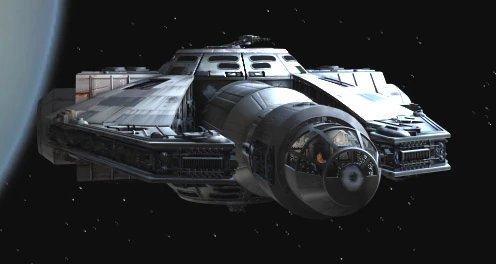

-The Kaloor Vision-
Name: The Kaloor Vision / The Vision
Model: YT-2000 Corellian Light Freighter
Appearance:
The Kaloor Vision is a modified Corellian light freighter, known for its versatility and speed.
Its exterior is adorned with custom paintwork that combines a blend of deep blue and black accents.
Kai has added her personal touch by painting an Evergreen tree, symbolizing hope and rebellion, near the ship's cockpit.
Length: 34 meters
Wingspan: 28 meters
Exterior Features:
The ship boasts a sleek and streamlined design, which not only enhances its aesthetic but also contributes to its speed and maneuverability.
Twin forward-facing blaster cannons are mounted on the ship's hull for defensive purposes.
The ship's sensor array is subtly integrated into the hull to reduce its profile and improve stealth capabilities.
Retractable landing gear allows for smooth takeoffs and landings on various terrains.
Interior Features:
The interior of the Kaloor Vision is designed for both comfort and functionality.
A cozy living quarters provide sleeping and resting space for Kai. The living quarters are decorated with personal items and mementos.
A small garden area with planters and grow lights where Kai cultivates herbs and plants for her herbal medicine.
Joan’s room is situated in the back of the ship near the observation deck.
The cockpit is equipped with state-of-the-art navigation and communication systems, including a holographic display and a co-pilot seat for R2-J11.
The central cargo hold is modular and can be configured for various purposes, such as carrying passengers, smuggling compartments, or additional cargo storage.
Concealed smuggling compartments are strategically hidden within the cargo hold for discreet transport of contraband or sensitive items.
An onboard workshop with tools, spare parts, and workbenches for Kai and R2-J11 to perform ship repairs and maintenance.
A compact medical bay equipped with basic medical supplies and equipment, where Kai can treat injuries and ailments.
A small kitchen area equipped with a food synthesizer and basic cooking facilities.
Customizations and Upgrades:
The ship has been extensively modified by Kai to improve its speed, agility, and defensive capabilities.
Upgraded hyperdrive and sunlight engines ensure the Kaloor Vision can make quick getaways and navigate dangerous territories.
Advanced shielding and a sensor jamming system provide additional protection and allow the ship to slip through Imperial blockades.
The concealed cargo compartments are equipped with smuggling compartments to transport goods discreetly.
2 notes
·
View notes
Text
Submitted via Google Form:
There was a question awhile ago where someone wanted skyscrapers very high up that but wasn't a great idea since it would cause issues if systems failed and you couldn't remove the top floors to repair them on the ground. Wouldn't spaceships have that same problem way worse when they are smack dab in the middle of space and nowhere near any place to land?
Tex: Ideally, spaceships have fulfilled the energy requirements to exist, because they would need to either break orbit or be built in dry docks in orbit to a planet, which is the majority of the issue with skyscrapers. Additionally, spaceships will probably have by default the benefit of altering their internal gravity, and if the engineers are good at what they do, a modularity to shut down specific areas for repairs without potentially breaking the entire system.
Feral: Unless I’m not referencing the correct previous asks, we really weren’t saying that the problem with maintenance on the top floors of 7km tall skyscrapers is that you couldn’t remove them to repair them on the ground - if there are skyscrapers that are 7km tall, there are going to have to be cranes that are taller to have built them. This actually puts spaceships in a better position to have repairs done because there’s no gravity to contend with.
The problem is that the people inside those top floors would be exposed to the environmental factors of being 7km above sea level, and yes, that would obviously also be catastrophic to the people inside a spaceship with a hull breach. Spaceships, however, could have a much easier time being compartmentalized with air locks and such so that people could be protected in one area while there’s damage in another. I brought this up as difficult to achieve in a skyscraper due to the varying conditions different floors of the same building would be subject to - in a spaceship, all external conditions are equal.
6 notes
·
View notes
Text
Sure, tech in Campoestela might be powerful and made of carbon nanotubes and fusion reactors (or maybe some technobabble dark energy condenser), but it's all tried, tested, and modular, enphasis on modular. While the tech itself is complex, spaceships hulls are designed to fit and replace any kind of components with ease, from passenger compartments (which like I said before are more like pods stuck to the cargo bay) to reactors and engines
So, there is totally an episode where Beto & Co. get a flat tire malfunctioning engine nacelle and have to replace it, like this:

These aren't NASA superspecialized expensive vehicles... It's very much like bush pilots in the Amazon, Siberia, Outback, etc. who are able to keep planes running by cannibalizing other engines. In some parts of Colombia, there are DC-3s built before WWII that are still flying because their engineers maintain it like that, replacing the whole engine if it needs to and it just keeps running.
12 notes
·
View notes